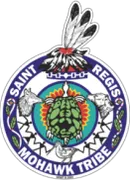2016 St. Regis River Mussel Restoration
By Jessica L. Jock (PI, St. Lawrence River AOC Program Manager)
In May 2016, Saint Regis Mohawk Tribe (SRMT) Environment Division received $98,988 in financial support from U.S. Environmental Protection Agency (USEPA) Great Lakes Restoration Initiative (GLRI) to conduct pre-construction mussel surveys and carry out mussel salvage and relocation restorative tasks. These actions were to proactively mitigate unintended loss of native mussel species to select areas of the St. Regis River associated with the Hogansburg Dam removal. Freshwater mussels play an important role in riverine systems by providing ecological services such as water clarification, nutrient recycling, food particle cycling to other benthic organisms, and act as a food source to aquatic organisms such as muskrats, otters, raccoon and some fish (i.e. lake sturgeon). The pre-construction mussel surveys were conducted to identify species presence and abundance in the area upstream the dam expected to be affected by the water drawdown and dam removal. Findings from the mussel survey were used to detail the relocation plan and strategy.
A Quality Assurance Project Plan (QAPP) was developed with specific data quality objectives for field surveys conducted June 13-24th, 2016. In 8-working days, SRMT Environment Division staff collected 6,406 live mussels representative of 11-species of mussels. Species collected included Strophitus undulatus, Ligumia recta, Lampsilis cariosa, Elliptio complanata, Alasmidonta marginata, Alasmidonta undulatus, Lampsilis radiata, Pyganodon cataracta, Lampsilis cardium, Pyganodon grandis, and Anodontoides ferussacianus. Of the 6,406 live mussels collected, 95.7 % were E. complanata. Of the 11 species, four are New York (NY) Species of Greatest Conservation Need (SGCN): A. marginata, L. cariosa, L. cardium, and L. recta. All mussels were identified by Dr. J. Mark Erickson, and voucher specimens were verified by Dr. Denise Mayer, Malacology Collections Manager at the New York State Museum (NYSM).
Results of the field surveys conducted in June 2016 were used to develop the mussel salvage and relocation plan for the stranded mussels during water drawdown and dam demolition (2016 St. Regis River Mussel Relocation Plan). Drawdown began on June 27th, and dam demolition began week of July 25th, 2016. All mussel salvage and relocation efforts were conducted June 30th - July 27th, 2016. All Elliptio complanata were placed in deeper waters in the main channel while non-Elliptio species were relocated upstream to an un-impacted relocation pool. During that period of time 66,539 mussels were relocated, of those 7,321 were mussels from the impoundment, and 6,813 mussels were hand-planted in a relocation pool upstream. Of the 6,813 mussels hand-planted 96% of them were Lampsilis cariosa or Lampsilis cardium.
A 1-month and 1-year post relocation mortality assessment in the relocation pool was conducted. During the 1-month assessment, 113 dead shells were collected (of the 6,813 replanted) thus indicating a 98% survival rate. The 1-year post relocation mortality assessment did not indicate any unusual or new mussel mortality.
The 2016 St. Regis River Freshwater Mussel Restoration final report sections 1-5 no Appendices can be found here, the appendices are available upon request. Photos demonstrating the different species present in the St. Regis River and activities undertaken by SRMT Environment Division staff in 2016 for mussels can be observed in slide presentations below.
Slide Show Presentations


